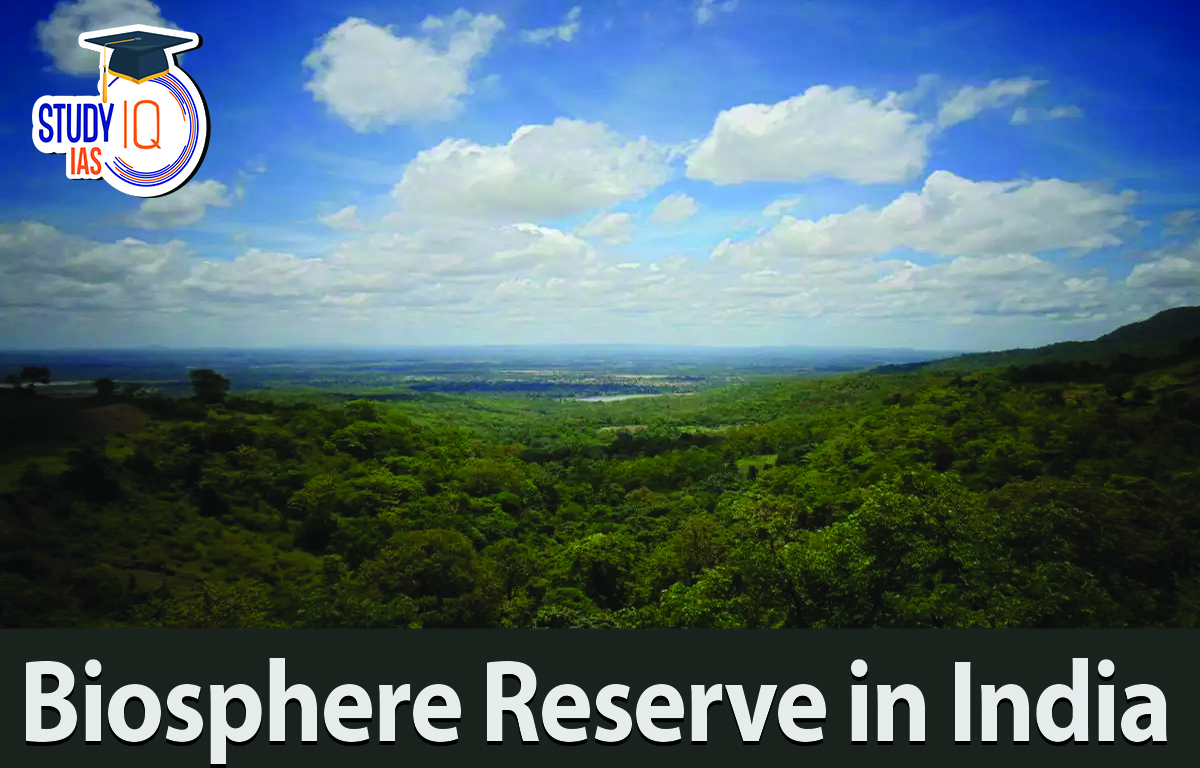Table of Contents
Biosphere Reserves in India
Biosphere Reserves in India: Biosphere reserves are protected areas set up to keep plants and animals safe. They also help preserve the traditional way of life of local tribes. These reserves protect an area’s rich biodiversity.
According to UNESCO, “Biosphere reserves are areas of land and coast that help balance protecting nature with using its resources sustainably.” They are recognized worldwide, chosen by national governments, and are managed by the countries where they are located.
The Indian government has established 18 biosphere reserves to protect important natural areas. Some economic activities are allowed between the protected core areas and the buffer zones. This helps to protect both the local people and the wildlife.
Biosphere Reserves in India History
Two years after starting the MAB-Man and Biosphere program, UNESCO announced the network of biosphere reserves in 1971. These areas work with the IUCN (International Union for Conservation of Nature) to protect nature.
Biosphere Reserves focus on balancing nature conservation with social, economic, and cultural growth. However, they are not governed by specific laws. The first Biosphere Reserves were established in 1979, and now there are 701 Biosphere Reserves in 124 countries, including 21 that cross national borders.
Biosphere Reserves in India Structure
Core Areas
The Core Area of a Biosphere Reserve is the safest part and may have native plants and animals. It is a great place for many types of plants and animals and might also be home to unique species. The wild relatives of important species are found here. This area is usually a national park or sanctuary, protected by the Wildlife Act of 1972.
Buffer Zone
The main area is surrounded by a buffer zone. This zone is designed to help protect the core area. It can include natural plants, farmland, forests, fishing areas, and ranches. These places can be used for study or to improve product quality while also helping to protect nature. Besides recreational and tourism businesses, this area might also have schools. In many biosphere reserves, the buffer zone has less human activity compared to the transition zone.
Transition Zone
The outer part of a biosphere reserve where people live and work using natural resources in a responsible way, is called a “transition area” or “area of collaboration.” To achieve the goals of the biosphere reserve, everyone needs to work together. In this space, local governments, environmental groups, researchers, non-profits, and others come together to decide the best ways to manage and use the area for everyone’s benefit.
Biosphere Reserves in India List
Here is a complete updated List of Biosphere reserves in India:
| Name of Biosphere | Year of Notification | Location |
| Nilgiri | 1986 | Tamil Nadu, Kerala and Karnataka |
| Nanda Devi | 1988 | Uttarakhand |
| Nokrek | 1988 | Meghalaya |
| Great Nicobar | 1989 | A&N Islands |
| Gulf of Mannar | 1989 | Tamil Nadu |
| Manas | 1989 | Assam |
| Sunderbans | 1989 | West Bengal |
| Simlipal | 1994 | Odhisa |
| Dibru-Saikhowa | 1997 | Assam |
| Dehang-Dibang | 1998 | Arunachal Pradesh |
| Pachmarhi | 1999 | Madhya Pradesh |
| Khangchendzonga | 2000 | Sikkim |
| Agasthyamalai | 2001 | Kerala |
| Achanakamar – Amarkantak | 2005 | Madhya Pradesh and Chhattishgarh State |
| Kachchh | 2008 | Gujarat |
| Cold Desert | 2009 | Himachal Pradesh |
| Seshachalam Hills | 2010 | Andhra Pradesh |
| Panna | 2011 | Madhya Pradesh |
UNESCO Protected Biosphere Reserves List
12 out of the 18 Biosphere reserves are a part of the world Network of Biosphere reserves, based on the UNESCO man and Biosphere Programme list.
| Year | Name | States |
| 2000 | Nilgiri Biosphere Reserve | Tamil Nadu |
| 2001 | Gulf of Mannar Biosphere Reserve | Tamil Nadu |
| 2001 | Sundarbans Biosphere Reserve | West Bengal |
| 2004 | Nanda Devi Biosphere Reserve | Uttarakhand |
| 2009 | Pachmarhi Biosphere Reserve | Madhya Pradesh |
| 2009 | Nokrek Biosphere Reserve | Meghalaya |
| 2009 | Simlipal Biosphere Reserve | Odisha |
| 2012 | Achanakmar-Amarkantak Biosphere Reserve | Chhattisgarh |
| 2013 | Great Nicobar Biosphere Reserve | Great Nicobar |
| 2016 | Agasthyamala Biosphere Reserve | Kerala and Tamil Nadu |
| 2018 | Kanchenjunga Biosphere Reserve | Part of North and West Sikkim districts |
| 2020 | Panna Biosphere Reserve | Madhya Pradesh |
Biosphere Reserves of India UPSC
- The Mahendragiri Hill Complex would become a Biosphere Reserve, as suggested by the government of Odisha. If included, it will become Simlipal Biosphere Reserve the second biosphere reserve in Odisha.
-
World’s Biosphere reserves distribution - 85 sites in 31 countries in Africa
- 33 locations in 12 Arab nations
- 157 locations in 24 nations around Asia and the Pacific
- 302 locations in 38 nations across Europe and North AmericaLatin America and the Caribbean contain 21 countries and 130 sites
- The following table shows how the world’s biosphere reserves.
- Panna Biosphere Reserve also received the designation of UNESCO Protected Biosphere Reserve internationally. The Indian Khangchendzonga Biosphere Reserve was also added to this list in 2018 before the status was granted in the year 2020.
Other Indian Geography Topics
Other Fundamental Geography Topics


 Important Lakes of India, State wise and...
Important Lakes of India, State wise and...
 Buddhism History, Origin, Sect, Councils...
Buddhism History, Origin, Sect, Councils...
 Andaman and Nicobar Islands, History, Cl...
Andaman and Nicobar Islands, History, Cl...





















